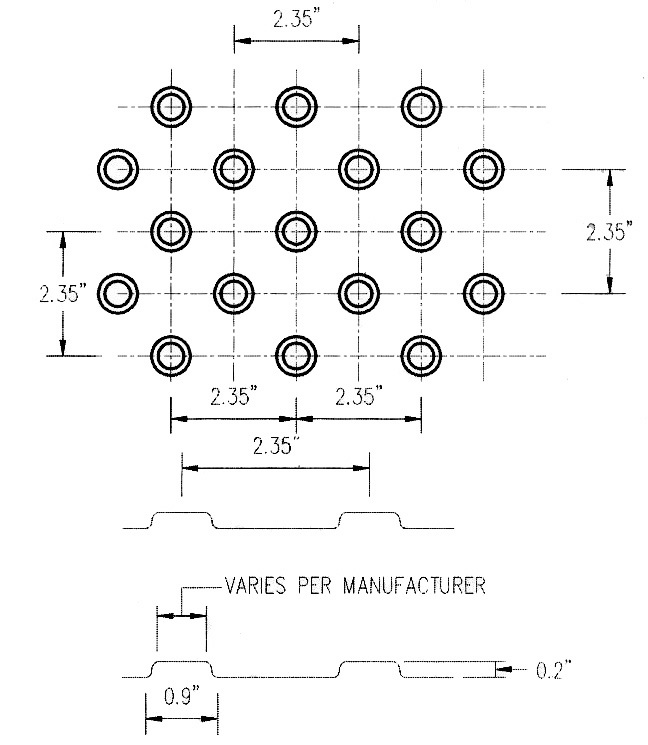Detectable Warnings [4.29]
People with little or no usable vision use environmental cues for safe and independent travel. These cues may include ambient sounds, edges and other physical elements that can be sensed by using a cane, and texture changes underfoot. Curbs are an important cue. Where curbs are lacking, such as at curb ramps, vehicle drop-offs, and depressed corners at intersections, people with vision impairments may not be able to discern the boundary between pedestrian and vehicular areas. ADAAG originally required detectable warnings on curb ramps, at areas where walking surfaces blend with vehicular ways without curb separation, railings, or other elements, and at the edges of reflecting pools not protected by railings, walls, or curbs.
Temporary Suspension.
Temporary Suspension
In response to business and user concerns about the need for the detectable warnings specified in 4.29 at curb ramps and hazardous vehicular areas, the Access Board suspended the requirement pending further study. This suspension is in effect until July 26,1998; extension of this suspension to July 26, 2000, has been proposed. This suspends the requirements for detectable warnings at:
Detectable warnings are not prohibited by this suspension; jurisdictions may continue to install the truncated domes specified in ADAAG or other surfaces or technologies if they wish but are not obligated to do so. (If a requirement for detectable warnings is re-instituted after the suspension, it would apply to new construction or alterations occurring after re-instatement and not apply retroactively to work undertaken during the period of suspension).
Transit Facilities: Rail Stations
Much of the early research on detectable warnings was conducted at rapid rail stations and the requirement to provide a detectable warning remains in effect along platform edges in transit stations [10.3.1(8)]. It applies to new and altered rapid, light, commuter, and intercity rail stations. Detectable warnings are also required in existing "key" stations serving rapid, light, and commuter rail systems and all existing intercity rail systems by dates specified in regulations issued by the Department of Transportation.
Platform Edges
The detectable warning must be placed at the platform edge and extend the full platform length in a 24 inch depth. This depth is an absolute dimension, not a minimum. Some platforms are edged with a buffer material that is designed to break away if hit by cargo trains. This material extends beyond the normal vehicle envelope. Where this breakaway material is installed at a platform edge, the width of the detectable warning surface can begin at the edge of the breakaway material rather than at the edge of the platform; otherwise, the detectable warning must extend to the edge of the platform. Since the sway of some rail cars may overlap a platform edge, the area of the detectable warning installation should not be considered a safety zone but rather an indication of an adjacent drop-off or platform edge. Where there is no specific edge to a vehicle boarding area, the detectable warning should be placed at the boundary of the vehicle dynamic envelope.
Equivalent Facilitation
The provision of equivalent facilitation in ADAAG 2.2 permits departures from ADAAG requirements that provide equal or greater access. The Department of Transportation's ADA regulations establish a procedure through which an agency or manufacturer may apply for a determination of equivalent facilitation for alternative designs or technologies. The Department, in consultation with the Access Board, has granted equivalent facilitation for a design similar to the ADAAG specification but having a dome base diameter of 1.325mrn and a spacing of 2.8mm.
Contrast
Interior applications require that the warning feature provide contrast in resilience or in sound when sensed with a cane. The domes and their matrix must also offer a strong visual contrast to adjacent pedestrian surfaces. Recommendation: Although ADAAG does not specify values for light-on-dark or dark-on-light contrast, a minimum 70% light reflectance contrast is recommended.
Doors to Hazardous Areas (Reserved) [4.29.3] and Stairs (Reserved) [4.29.4]
In the absence of a clear consensus on the need or specification for detectable warnings at doors and stairs, no requirement has been specified in ADAAG. Earlier accessibility standards once contained a requirement for these areas.
Detectable Warnings on Walking Surfaces [4.29.2]
Detectable warnings are intended to alert pedestrians of an imminent hazard but are not designed as wayfinding devices. Research indicates that the most effective detectable warning:
-
has a unique texture distinct from other common surfaces in the environment
-
adjoins or abuts the hazard to signal impending change
-
extends beyond the average stride length so that one can detect, understand, and react to it before encountering the hazard
The truncated dome specification and intended offset pattern was found to be the most effective in providing a distinct patterning detectable by cane and underfoot. The degree of truncation, which is not specified, varies according to the manufacturer.


User Comments/Questions
Add Comment/Question